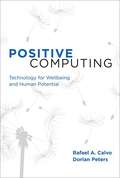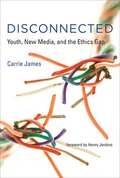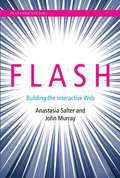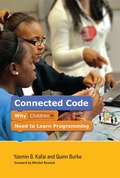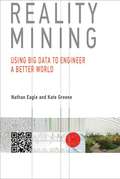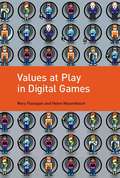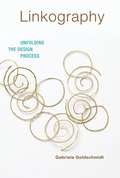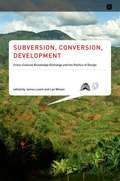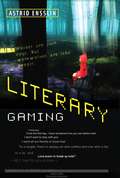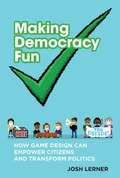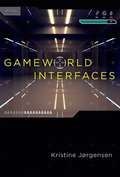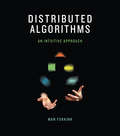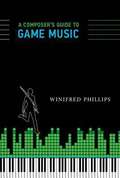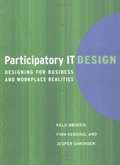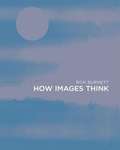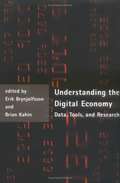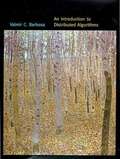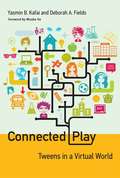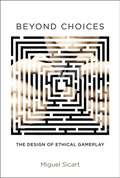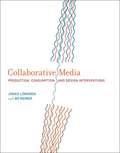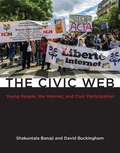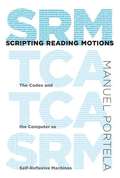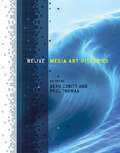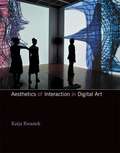- Table View
- List View
Positive Computing
by Dorian Peters Rafael A. CalvoOn the eve of Google's IPO in 2004, Larry Page and Sergey Brin vowed not to be evil. Today, a growing number of technologists would go further, trying to ensure that their work actively improves people's lives. Technology, so pervasive and ubiquitous, has the capacity to increase stress and suffering; but it also has the less-heralded potential to improve the well-being of individuals, society, and the planet. In this book, Rafael Calvo and Dorian Peters investigate what they term "positive computing" -- the design and development of technology to support psychological well-being and human potential. Calvo and Peters explain that technologists' growing interest in social good is part of a larger public concern about how our digital experience affects our emotions and our quality of life -- which itself reflects an emerging focus on humanistic values in many different disciplines. Synthesizing theory, knowledge, and empirical methodologies from a variety of fields, they offer a rigorous and coherent foundational framework for positive computing. Sidebars by experts from psychology, neuroscience, human--computer interaction, and other disciplines supply essential context. Calvo and Peters examine specific well-being factors, including positive emotions, self-awareness, mindfulness, empathy, and compassion, and explore how technology can support these factors. Finally, they offer suggestions for future research and funding.SidebarsTimothy N. Bickmore, Jeremy Bailenson, danah boyd, Jane Burns, David R. Caruso, Mihaly Csikszentmihalyi, Felicia Huppert, Mary-Helen Immordino-Yang, Adele Krusche and J. Mark G. Williams, Jane McGonigal, Jonathan Nicholas, Don Norman, Yvonne Rogers
Disconnected
by Carrie JamesFresh from a party, a teen posts a photo on Facebook of a friend drinking a beer. A college student repurposes an article from Wikipedia for a paper. A group of players in a multiplayer online game routinely cheat new players by selling them worthless virtual accessories for high prices. In Disconnected, Carrie James examines how young people and the adults in their lives think about these sorts of online dilemmas, describing ethical blind spots and disconnects. Drawing on extensive interviews with young people between the ages of 10 and 25, James describes the nature of their thinking about privacy, property, and participation online. She identifies three ways that young people approach online activities. A teen might practice self-focused thinking, concerned mostly about consequences for herself; moral thinking, concerned about the consequences for people he knows; or ethical thinking, concerned about unknown individuals and larger communities. James finds, among other things, that youth are often blind to moral or ethical concerns about privacy; that attitudes toward property range from "what's theirs is theirs" to "free for all"; that hostile speech can be met with a belief that online content is "just a joke"; and that adults who are consulted about such dilemmas often emphasize personal safety issues over online ethics and citizenship. Considering ways to address the digital ethics gap, James offers a vision of conscientious connectivity, which involves ethical thinking skills but, perhaps more important, is marked by sensitivity to the dilemmas posed by online life, a motivation to wrestle with them, and a sense of moral agency that supports socially positive online actions.
Flash
by Anastasia Salter John MurrayAdobe Flash began as a simple animation tool and grew into a multimedia platform that offered a generation of creators and innovators an astonishing range of opportunities to develop and distribute new kinds of digital content. For the better part of a decade, Flash was the de facto standard for dynamic online media, empowering amateur and professional developers to shape the future of the interactive Web. In this book, Anastasia Salter and John Murray trace the evolution of Flash into one of the engines of participatory culture. Salter and Murray investigate Flash as both a fundamental force that shaped perceptions of the web and a key technology that enabled innovative interactive experiences and new forms of gaming. They examine a series of works that exemplify Flash's role in shaping the experience and expectations of web multimedia. Topics include Flash as a platform for developing animation (and the "Flashimation" aesthetic); its capacities for scripting and interactive design; games and genres enabled by the reconstruction of the browser as a games portal; forms and genres of media art that use Flash; and Flash's stance on openness and standards--including its platform-defining battle over the ability to participate in Apple's own proprietary platforms. Flash's exit from the mobile environment in 2011 led some to declare that Flash was dead. But, as Salter and Murray show, not only does Flash live, but its role as a definitive cross-platform tool continues to influence web experience.
Connected Code
by Mitchel Resnick Quinn Burke Yasmin B. KafaiCoding, once considered an arcane craft practiced by solitary techies, is now recognized by educators and theorists as a crucial skill, even a new literacy, for all children. Programming is often promoted in K-12 schools as a way to encourage "computational thinking" -- which has now become the umbrella term for understanding what computer science has to contribute to reasoning and communicating in an ever-increasingly digital world.In Connected Code, Yasmin Kafai and Quinn Burke argue that although computational thinking represents an excellent starting point, the broader conception of "computational participation" better captures the twenty-first-century reality. Computational participation moves beyond the individual to focus on wider social networks and a DIY culture of digital "making." Kafai and Burke describe contemporary examples of computational participation: students who code not for the sake of coding but to create games, stories, and animations to share; the emergence of youth programming communities; the practices and ethical challenges of remixing (rather than starting from scratch); and the move beyond stationary screens to programmable toys, tools, and textiles.
Reality Mining
by Kate Greene Nathan EagleBig Data is made up of lots of little data: numbers entered into cell phones, addresses entered into GPS devices, visits to websites, online purchases, ATM transactions, and any other activity that leaves a digital trail. Although the abuse of Big Data -- surveillance, spying, hacking -- has made headlines, it shouldn't overshadow the abundant positive applications of Big Data. In Reality Mining, Nathan Eagle and Kate Greene cut through the hype and the headlines to explore the positive potential of Big Data, showing the ways in which the analysis of Big Data ("Reality Mining") can be used to improve human systems as varied as political polling and disease tracking, while considering user privacy.Eagle, a recognized expert in the field, and Greene, an experienced technology journalist, describe Reality Mining at five different levels: the individual, the neighborhood and organization, the city, the nation, and the world. For each level, they first offer a nontechnical explanation of data collection methods and then describe applications and systems that have been or could be built. These include a mobile app that helps smokers quit smoking; a workplace "knowledge system"; the use of GPS, Wi-Fi, and mobile phone data to manage and predict traffic flows; and the analysis of social media to track the spread of disease. Eagle and Greene argue that Big Data, used respectfully and responsibly, can help people live better, healthier, and happier lives.
Values at Play in Digital Games
by Mary Flanagan Helen NissenbaumAll games express and embody human values, providing a compelling arena in which we play out beliefs and ideas. "Big ideas" such as justice, equity, honesty, and cooperation -- as well as other kinds of ideas, including violence, exploitation, and greed -- may emerge in games whether designers intend them or not. In this book, Mary Flanagan and Helen Nissenbaum present Values at Play, a theoretical and practical framework for identifying socially recognized moral and political values in digital games. Values at Play can also serve as a guide to designers who seek to implement values in the conception and design of their games. After developing a theoretical foundation for their proposal, Flanagan and Nissenbaum provide detailed examinations of selected games, demonstrating the many ways in which values are embedded in them. They introduce the Values at Play heuristic, a systematic approach for incorporating values into the game design process. Interspersed among the book's chapters are texts by designers who have put Values at Play into practice by accepting values as a design constraint like any other, offering a real-world perspective on the design challenges involved.
Linkography
by Gabriela GoldschmidtThis book presents linkography, a method for the notation and analysis of the design process. Developed by Gabriela Goldschmidt in an attempt to clarify designing, linkography documents how designers think, generate ideas, put them to the test, and combine them into something meaningful. With linkography, Goldschmidt shows that there is a logic to the creative process -- that it is not, as is often supposed, pure magic. Linkography draws on design practice, protocol analysis, and insights from cognitive psychology. Goldschmidt argues that the generation of ideas (and their inspection and adjustment) evolves over a large number of small steps, which she terms design moves. These combine in a network of moves, and the patterns of links in the networks manifest a "good fit," or congruence, among the ideas. Goldschmidt explains what parts of the design process can be observed and measured in a linkograph, describing its features and notation conventions. The most significant elements in a linkograph are critical moves, which are particularly rich in links. Goldschmidt presents studies that show the importance of critical moves in design thinking; describes cases that demonstrate linkography's effectiveness in studying the creative process in design (focusing on the good fit); and offers thirteen linkographic studies conducted by other researchers that show the potential of linkography in design thinking research and beyond. Linkography is the first book-length treatment of an approach to design thinking that has already proved influential in the field.
Subversion, Conversion, Development
by James Leach Lee WilsonThis book explores alternative cultural encounters with and around information technologies. These encounters are alternative because they counter dominant, Western-oriented notions of media consumption; they include media practices as forms of cultural resistance and subversion, "DIY cultures," and other nonmainstream models of technology production. The contributors -- leading thinkers in science and technology studies, anthropology, and software design -- pay special attention to the specific inflections that different cultures and communities give to the value of knowledge. The richly detailed accounts presented here challenge the dominant view of knowledge as a neutral good -- information available for representation and encoding but separated from all social relations. The chapters examine specific cases in which the forms of knowledge and cross-cultural encounters are shaping technology use and development. They consider design, use, and reuse of technological tools, including databases, GPS devices, books, and computers, in locations that range from Australia and New Guinea to Germany and the United States. ContributorsPoline Bala, Alan Blackwell, Wade Chambers, Michael Christie, Hildegard Diemberger, Stephen Hugh-Jones, James Leach, Jerome Lewis, Dawn Nafus, Gregers Petersen, Marilyn Strathern, David Turnbull, Helen Verran, Laura Watts, Lee Wilson
Literary Gaming
by Astrid EnsslinIn this book, Astrid Ensslin examines literary videogames -- hybrid digital artifacts that have elements of both games and literature, combining the ludic and the literary. These works can be considered verbal art in the broadest sense (in that language plays a significant part in their aesthetic appeal); they draw on game mechanics; and they are digital-born, dependent on a digital medium (unlike, for example, conventional books read on e-readers). They employ narrative, dramatic, and poetic techniques in order to explore the affordances and limitations of ludic structures and processes, and they are designed to make players reflect on conventional game characteristics. Ensslin approaches these hybrid works as a new form of experimental literary art that requires novel ways of playing and reading. She proposes a systematic method for analyzing literary-ludic (L-L) texts that takes into account the analytic concerns of both literary stylistics and ludology.After establishing the theoretical underpinnings of her proposal, Ensslin introduces the L-L spectrum as an analytical framework for literary games. Based on the phenomenological distinction between deep and hyper attention, the L-L spectrum charts a work's relative emphases on reading and gameplay. Ensslin applies this analytical toolkit to close readings of selected works, moving from the predominantly literary to the primarily ludic, from online hypermedia fiction to Flash fiction to interactive fiction to poetry games to a highly designed literary "auteur" game. Finally, she considers her innovative analytical methodology in the context of contemporary ludology, media studies, and literary discourse analysis.
Making Democracy Fun
by Josh LernerAnyone who has ever been to a public hearing or community meeting would agree that participatory democracy can be boring. Hours of repetitive presentations, alternatingly alarmist or complacent, for or against, accompanied by constant heckling, often with no clear outcome or decision. Is this the best democracy can offer? In Making Democracy Fun, Josh Lerner offers a novel solution for the sad state of our deliberative democracy: the power of good game design. What if public meetings featured competition and collaboration (such as team challenges), clear rules (presented and modeled in multiple ways), measurable progress (such as scores and levels), and engaging sounds and visuals? These game mechanics would make meetings more effective and more enjoyable -- even fun. Lerner reports that institutions as diverse as the United Nations, the U.S. Army, and grassroots community groups are already using games and game-like processes to encourage participation. Drawing on more than a decade of practical experience and extensive research, he explains how games have been integrated into a variety of public programs in North and South America. He offers rich stories of game techniques in action, in children's councils, social service programs, and participatory budgeting and planning. With these real-world examples in mind, Lerner describes five kinds of games and twenty-six game mechanics that are especially relevant for democracy. He finds that when governments and organizations use games and design their programs to be more like games, public participation becomes more attractive, effective, and transparent. Game design can make democracy fun -- and make it work.
Gameworld Interfaces
by Kristine JørgensenComputer games usually take one of two approaches to presenting game information to players. A game might offer information naturalistically, as part of the game's imaginary universe; or it might augment the world of the game with overlays, symbols, and menus. In this book, Kristine Jørgensen investigates both kinds of gameworld interfaces. She shows that although the naturalistic approach may appear more integral to the imaginary world of the game, both the invisible and visible interfaces effectively present information that players need in order to interact with the game and its rules. The symbolic, less naturalistic approach would seem to conflict with the idea of a coherent, autonomous fictional universe; but, Jørgensen argues, gameworlds are not governed by the pursuit of fictional coherence but by the logics of game mechanics. This is characteristic of gameworlds and distinguishes them from other traditional fictional worlds. Jørgensen investigates gameworld interfaces from the perspectives of both game designers and players. She draws on interviews with the design teams of Harmonix Music (producer of Rock Band and other music games) and Turbine Inc. (producer of such massively multiplayer online games as Lord of the Rings Online), many hours of gameplay, and extensive interviews and observations of players. The player studies focus on four games representing different genres: Crysis, Command & Conquer 3: Tiberian Wars, The Sims 2, and Diablo 2. Finally, she presents a theory of game user interfaces and considers the implications of this theory for game design.
Distributed Algorithms: An Intuitive Approach
by Wan FokkinkThis book offers students and researchers a guide to distributed algorithms that emphasizes examples and exercises rather than the intricacies of mathematical models. It avoids mathematical argumentation, often a stumbling block for students, teaching algorithmic thought rather than proofs and logic. This approach allows the student to learn a large number of algorithms within a relatively short span of time. Algorithms are explained through brief, informal descriptions, illuminating examples, and practical exercises. The examples and exercises allow readers to understand algorithms intuitively and from different perspectives. Proof sketches, arguing the correctness of an algorithm or explaining the idea behind fundamental results, are also included. An appendix offers pseudocode descriptions of many algorithms.Distributed algorithms are performed by a collection of computers that send messages to each other or by multiple software threads that use the same shared memory. The algorithms presented in the book are for the most part "classics," selected because they shed light on the algorithmic design of distributed systems or on key issues in distributed computing and concurrent programming. Distributed Algorithms can be used in courses for upper-level undergraduates or graduate students in computer science, or as a reference for researchers in the field.
A Composer's Guide to Game Music
by Winifred PhillipsMusic in video games is often a sophisticated, complex composition that serves toengage the player, set the pace of play, and aid interactivity. Composers of video game music mustmaster an array of specialized skills not taught in the conservatory, including the creation oflinear loops, music chunks for horizontal resequencing, and compositional fragments for use within agenerative framework. In A Composer's Guide to Game Music, Winifred Phillips --herself an award-winning composer of video game music -- provides a comprehensive, practical guidethat leads an aspiring video game composer from acquiring the necessary creative skills tounderstanding the function of music in games to finding work in the field. Musicians and composersmay be drawn to game music composition because the game industry is a multibillion-dollar,employment-generating economic powerhouse, but, Phillips writes, the most important qualificationfor a musician who wants to become a game music composer is a love of video games. Phillips offersdetailed coverage of essential topics, including musicianship and composition experience; immersion;musical themes; music and game genres; workflow; working with a development team; linear music;interactive music, both rendered and generative; audio technology, from mixers and preamps tosoftware; and running a business. A Composer's Guide to Game Music offersindispensable guidance for musicians and composers who want to deploy their creativity in a dynamicand growing industry, protect their musical identities while working in a highly technical field,and create great music within the constraints of a new medium.
Financial Modeling (3rd Edition)
by Simon BenningaToo often, finance courses stop short of making a connection between textbook finance and the problems of real-world business. Financial Modeling bridges this gap between theory and practice by providing a nuts-and-bolts guide to solving common financial models with spreadsheets. Simon Benninga takes the reader step by step through each model, showing how it can be solved using Microsoft Excel. The long-awaited third edition of this standard text maintains the "cookbook" features and Excel dependence that have made the first and second editions so popular. It also offers significant new material, with new chapters covering such topics as bank valuation, the Black-Litterman approach to portfolio optimization, Monte Carlo methods and their applications to option pricing, and using array functions and formulas. Other chapters, including those on basic financial calculations, portfolio models, calculating the variance-covariance matrix,and generating random numbers, have been revised, with many offering substantially new and improved material. Other areas covered include financial statement modeling, leasing, standard portfolio problems, value at risk (VaR), real options, duration and immunization, and term structure modeling. Technical chapters treat such topics as data tables, matrices, the Gauss-Seidel method, and tips for using Excel. The last section of the text covers the Visual Basic for Applications (VBA) techniques needed for the book. The accompanying CD contains Excel worksheets and solutions to end-of-chapter exercises.
Participatory IT Design: Designing for Business and Workplace Realities
by Keld Bodker Finn Kensing Jesper SimonsenThe goal of participatory IT design is to set sensible, general, and workable guidelines for the introduction of new information technology systems into an organization. Reflecting the latest systems-development research, this book encourages a business- oriented and socially sensitive approach that takes into consideration the specific organizational context as well as first-hand knowledge of users' work practices and allows all stakeholders--users, management, and staff--to participate in the process. Participatory IT Designis a guide to the theory and practice of this process that can be used as a reference work by IT professionals and as a textbook for classes in information technology at introductory through advanced levels. Drawing on the work of a ten-year research program in which the authors worked with Danish and American companies, the book offers a framework for carrying out IT design projects as well as case studies that stand as examples of the process. The method presented in Participatory IT Design--known as the MUST method, after a Danish acronym for theories and methods of initial analysis and design activities--was developed and tested in thirteen industrial design projects for companies and organizations that included an American airline, a multinational pharmaceutical company, a national broadcasting corporation, a multinational software house, and American and Danish universities. The first part of the book introduces the concepts and guidelines on which the method is based, while the second and third parts are designed as a practical toolbox for utilizing the MUST method. Part II describes the four phases of a design project--initiation, in-line analysis, in-depth analysis, and innovation. Part III explains the method's sixteen techniques and related representation tools, offering first an overview and then specific descriptions of each in separate sections.
How Images Think
by Ron BurnettDigital images are an integral part of all media, including television, film, photography, animation, video games, data visualization, and the Internet. In the digital world, spectators become navigators wending their way through a variety of interactive experiences, and images become spaces of visualization with more and more intelligence programmed into the very fabric of communication processes. In How Images Think, Ron Burnett explores this new ecology, which has transformed the relationships humans have with the image-based technologies they have created. So much intelligence has been programmed into these image-dependent technologies that it often seems as if images are "thinking"; ascribing thought to machines redefines our relationship with them and enlarges our ideas about body and mind. Burnett argues that the development of this new, closely interdependent relationship marks a turning point in our understanding of the connections between humans and machines. After presenting an overview of visual perception, Burnett examines the interactive modes of new technologies -- including computer games, virtual reality, digital photography, and film -- and locates digital images in a historical context. He argues that virtual images occupy a "middle space," combining the virtual and the real into an environment of visualization that blurs the distinctions between subject and object -- part of a continuum of experiences generated by creative choices by viewers, the results of which cannot be attributed either to images or to participants.
Understanding The Digital Economy: Data, Tools, and Research
by Erik Brynjolfsson Brian KahinThe rapid growth of electronic commerce, along with changes in information, computing, and communications, is having a profound effect on the United States economy. President Clinton recently directed the National Economic Council, in consultation with executive branch agencies, to analyze the economic implications of the Internet and electronic commerce domestically and internationally, and to consider new types of data collection and research that could be undertaken by public and private organizations. This book contains work presented at a conference held by executive branch agencies in May 1999 at the Department of Commerce. The goals of the conference were to assess current research on the digital economy, to engage the private sector in developing the research that informs investment and policy decisions, and to promote better understanding of the growth and socioeconomic implications of information technology and electronic commerce. Aspects of the digital economy addressed include macroeconomic assessment, organizational change, small business, access, market structure and competition, and employment and the workforce.
An Introduction to Distributed Algorithms
by Valmir C. BarbosaAn Introduction to Distributed Algorithms takes up some of the main concepts and algorithms, ranging from basic to advanced techniques and applications, that underlie the programming of distributed-memory systems such as computer networks, networks of workstations, and multiprocessors. Written from the broad perspective of distributed-memory systems in general it includes topics such as algorithms for maximum flow, program debugging, and simulation that do not appear in more orthodox texts on distributed algorithms. Moving from fundamentals to advances and applications, ten chapters--with exercises and bibliographic notes--cover a variety of topics. These include models of distributed computation, information propagation, leader election, distributed snapshots, network synchronization, self- stability, termination detection, deadlock detection, graph algorithms, mutual exclusion, program debugging, and simulation. All of the algorithms are presented in a clear, template- based format for the description of message-passing computations among the nodes of a connected graph. Such a generic setting allows the treatment of problems originating from many different application areas. The main ideas and algorithms are described in a way that balances intuition and formal rigor--most are preceded by a general intuitive discussion and followed by formal statements as to correctness complexity or other properties.
Connected Play: Tweens in a Virtual World
by Yasmin B. Kafai Deborah A. FieldsMillions of children visit virtual worlds every day. In such virtual play spaces as Habbo Hotel, Toontown, and Whyville, kids chat with friends from school, meet new people, construct avatars, and earn and spend virtual currency. In "Connected Play," Yasmin Kafai and Deborah Fields investigate what happens when kids play in virtual worlds, how this matters for their offline lives, and what this means for the design of educational opportunities in digital worlds. Play is fundamentally important for kids development, but, Kafai and Fields argue, to understand play in virtual worlds, we need to connect concerns of development and culture with those of digital media and learning. Kafai and Fields do this through a detailed study of kids play in Whyville, a massive, informal virtual world with educational content for tween players. Combining ethnographic accounts with analysis of logfile data, they present rich portraits and overviews of how kids learn to play in a digital domain, developing certain technological competencies; how kids learn to play well -- responsibly, respectfully, and safely; and how kids learn to play creatively, creating content that becomes a part of the virtual world itself.
Beyond Choices
by Miguel SicartToday's blockbuster video games -- and their never-ending sequels, sagas, and reboots -- provide plenty of excitement in high-resolution but for the most part fail to engage a player's moral imagination. In Beyond Choices, Miguel Sicart calls for a new generation of video and computer games that are ethically relevant by design. In the 1970s, mainstream films -- including The Godfather, Apocalypse Now, Raging Bull, and Taxi Driver -- filled theaters but also treated their audiences as thinking beings. Why can't mainstream video games have the same moral and aesthetic impact? Sicart argues that it is time for games to claim their place in the cultural landscape as vehicles for ethical reflection.Sicart looks at games in many manifestations: toys, analog games, computer and video games, interactive fictions, commercial entertainments, and independent releases. Drawing on philosophy, design theory, literary studies, aesthetics, and interviews with game developers, Sicart provides a systematic account of how games can be designed to challenge and enrich our moral lives. After discussing such topics as definition of ethical gameplay and the structure of the game as a designed object, Sicart offers a theory of the design of ethical game play. He also analyzes the ethical aspects of game play in a number of current games, including Spec Ops: The Line, Beautiful Escape: Dungeoneer, Fallout New Vegas, and Anna Anthropy's Dys4Ia. Games are designed to evoke specific emotions; games that engage players ethically, Sicart argues, enable us to explore and express our values through play.
Collaborative Media: Production, Consumption, and Design Interventions
by Jonas Löwgren Bo ReimerWith many new forms of digital media--including such popular social media as Facebook, Twitter, and Flickr -- the people formerly known as the audience no longer only consume but also produce and even design media. Jonas L'wgren and Bo Reimer term this phenomenon collaborative media, and in this book they investigate the qualities and characteristics of these forms of media in terms of what they enable people to do. They do so through an interdisciplinary research approach that combines the social sciences and humanities traditions of empirical and theoretical work with practice-based, design-oriented interventions. L'wgren and Reimer offer analysis and a series of illuminating case studies -- examples of projects in collaborative media that range from small multidisciplinary research experiments to commercial projects used by millions of people. L'wgren and Reimer discuss the case studies at three levels of analysis: society and the role of collaborative media in societal change; institutions and the relationship of collaborative media with established media structures; and tribes, the nurturing of small communities within a large technical infrastructure. They conclude by advocating an interventionist turn within social analysis and media design.
The Civic Web: Young People, the Internet and Civic Participation
by Shakuntala Banaji David BuckinghamThere has been widespread concern in contemporary Western societies about declining engagement in civic life; people are less inclined to vote, to join political parties, to campaign for social causes, or to trust political processes. Young people in particular are frequently described as alienated or apathetic. Some have looked optimistically to new media -- and particularly the Internet -- as a means of revitalizing civic life and democracy. Governments, political parties, charities, NGOs, activists, religious and ethnic groups, and grassroots organizations have created a range of youth-oriented websites that encourage widely divergent forms of civic engagement and use varying degrees of interactivity. But are young people really apathetic and lacking in motivation? Does the Internet have the power to re-engage those disenchanted with politics and civic life? Based on a major research project funded by the European Commission, this book attempts to understand the role of the Internet in promoting young peoples participation. Examples are drawn from Hungary, the Netherlands, Slovenia, Spain, Sweden, Turkey, and the United Kingdom -- countries offering contrasting political systems and cultural contexts. The book also addresses broader questions about the meaning of civic engagement, the nature of new forms of participation, and their implications for the future of civic life.
Scripting Reading Motions: The Codex and the Computer as Self-Reflexive Machines
by Manuel PortelaIn Scripting Reading Motions, Manuel Portela explores theexpressive use of book forms and programmable media in experimental works of both print andelectronic literature and finds a self-conscious play with the dynamics of reading and writing. Portela examines a series of print and digital works by Johanna Drucker, Mark Z. Danielewski, RuiTorres, Jim Andrews, and others, for the insights they yield about the semiotic and interpretiveactions through which readers produce meaning when interacting with codes. Analyzing these works asembodiments and simulations of the motions of reading, Portela pays particular attention to the waysin which awareness of eye movements and haptic interactions in both print and electronic media feedsback onto the material and semantic layers of the works. These feedbacks, he argues, sustainself-reflexive loops that link the body of the reader to the embodied work. Readers' haptic actionsand eye movements coinstantiate the object that they are reading. Porteladiscusses typographic and graphic marks as choreographic notations for reading movements; examinesdigital recreations of experimental print literary artifacts; considers reading motions in kineticand generated texts; analyzes the relationship of bibliographic, linguistic, and narrative coding inDanielewski's novel-poem, Only Revolutions; and describes emergent meanings ininteractive textual instruments. The expressive use of print and programmable media, Portela shows,offers a powerful model of the semiotic, interpretive, and affective operations embodied in readingprocesses.
Relive: Media Art Histories
by Sean Cubitt Paul ThomasIn "Relive," leading historians of the media arts grapple with this dilemma: how can we speak of "new media" and at the same time write the histories of these arts? These scholars and practitioners redefine the nature of the field, focusing on the materials of history -- the materials through which the past is mediated. Drawing on the tools of media archaeology and the history and philosophy of media, they propose a new materialist media art history. The contributors consider the idea of history and the artwork's moment in time; the intersection of geography and history in regional practice, illustrated by examples from eastern Europe, Australia, and New Zealand; the contradictory scales of evolution, life cycles, and bodily rhythms in bio art; and the history of the future -- how the future has been imagined, planned for, and established as a vector throughout the history of new media arts. These essays, written from widely diverse critical perspectives, capture a dynamic field at a moment of productive ferment. ContributorsSusan Ballard, Brogan Bunt, Andr's Burbano, Jon Cates, John Conomos, Martin Constable, Sean Cubitt, Francesca Franco, Darko Fritz, Zhang Ga, Monika Gorska-Olesinska, Ross Harley, Jens Hauser, Stephen Jones, Douglas Kahn, Ryszard W. Kluszczynski, Caroline Seck Langill, Leon Marvell, Rudy Rucker, Edward A. Shanken, Stelarc, Adele Tan, Paul Thomas, Darren Tofts, Joanna Walewska
Aesthetics of Interaction in Digital Art
by Katja Kwastek Niamh WardeSince the 1960s, artworks that involve the participation of the spectator have received extensive scholarly attention. Yet interactive artworks using digital media still present a challenge for academic art history. In this book, Katja Kwastek argues that the particular aesthetic experience enabled by these new media works can open up new perspectives for our understanding of art and media alike. Kwastek, herself an art historian, offers a set of theoretical and methodological tools that are suitable for understanding and analyzing not only new media art but also other contemporary art forms. Addressing both the theoretician and the practitioner, Kwastek provides an introduction to the history and the terminology of interactive art, a theory of the aesthetics of interaction, and exemplary case studies of interactive media art. Kwastek lays the historical and theoretical groundwork with discussions of processual strategies of twentieth-century art and theories of aesthetic experience, process aesthetics, play, and performance. She then develops an aesthetics of interaction, discussing such aspects as real space and data space, temporal structures, instrumental and phenomenal perspectives, and the relationship between materiality and interpretability. Finally, she applies her theory to specific works of interactive media art, including narratives in virtual and real space, interactive installations, and performance -- with case studies of works by Olia Lialina, Susanne Berkenheger, Stefan Schemat, Teri Rueb, Lynn Hershman, Agnes Heged's, Tmema, David Rokeby, Sonia Cillari, and Blast Theory.
